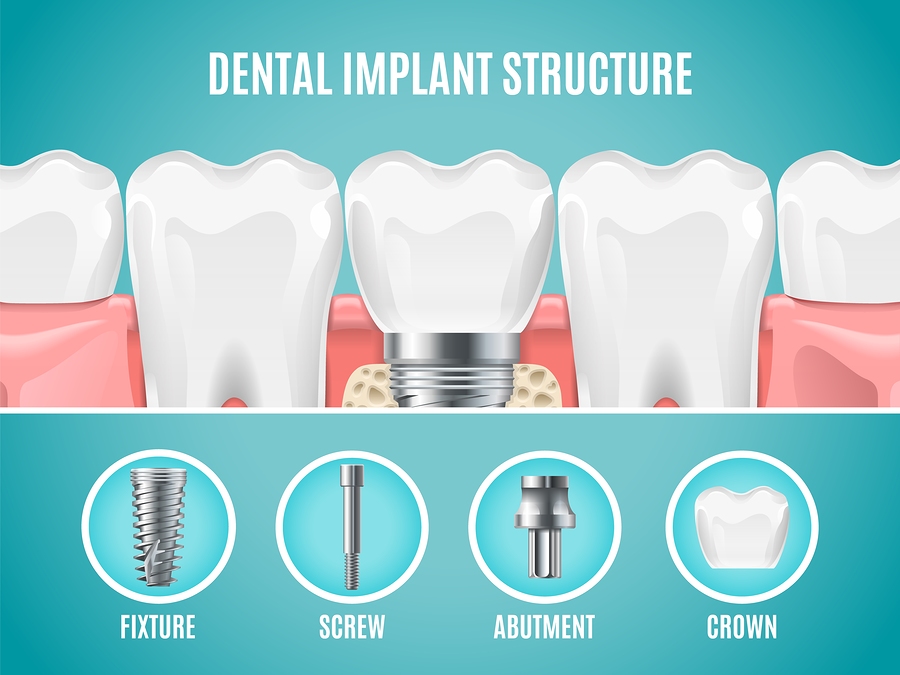Dental Sense for Dummies
Dental Sense for Dummies
Blog Article
How Dental Sense can Save You Time, Stress, and Money.
Table of ContentsDental Sense for DummiesThe Ultimate Guide To Dental SenseThe 5-Second Trick For Dental SenseAn Unbiased View of Dental Sense
are medical devices surgically implanted into the jaw to recover an individual's ability to chew or their appearance. They provide assistance for synthetic (phony) teeth, such as crowns, bridges, or dentures. When a tooth is shed as a result of injury or illness, a person can experience problems such as quick bone loss, faulty speech, or adjustments to eating patterns that cause pain.Dental implant systems include an oral implant body and dental implant joint and might also include a joint fixation screw. Dental implants. The oral implant body is surgically inserted in the jawbone instead of the tooth's root. The dental implant abutment is generally attached to the implant body by the joint addiction screw and extends with gums right into the mouth to sustain the attached man-made teeth
(https://yoomark.com/content/dental-implants-including-endosteal-subperiosteal-and-mini-types-offer-both-stability-and)Framework of The Oral Implant System selecting oral implants, speak to your oral provider regarding the potential advantages and dangers, and whether you are a candidate for the treatment. Things to take into consideration: Your total health is a crucial consider determining whether you are a good prospect for oral implants, the length of time it will take to recover, and how much time the implant may stay in location.
Smoking cigarettes may influence the recovery procedure and reduce the lasting success of the dental implant. The recovery process for the dental implant body might take numerous months or longer, throughout which time you normally have a short-lived joint instead of the tooth. the dental implant treatment: Very carefully adhere to the dental hygiene directions provided to you by your oral provider.
The Main Principles Of Dental Sense
Implant failing can lead to the need for an additional surgery to repair or change the implant system. Recovers the ability to eat Restores cosmetic appearance Assists maintain the jawbone from diminishing as a result of bone loss Preserves the health of the bordering bone and gum tissues Assists maintain adjacent (nearby) teeth stable Enhances lifestyle Damages to bordering natural teeth during implant placement Injury to the surrounding tissues during surgical procedure, such as sinus perforation Injury during surgical treatment (as an example, crack of bordering jawbone) Inadequate feature, such as seeming like the teeth do not bite with each other typically An experience that the tooth hangs or turning in position resulting from an abutment screw loosening up Implant body failing (looseness of the implant body) because of systemic infection, which may be most likely in people with unrestrained diabetics issues because of local infection in bone and periodontals sustaining the dental implant body due to postponed healing, which may be more probable in clients who smoke Trouble cleaning the periodontals around the dental implant, resulting in poor oral hygiene Unattended periodontal condition Post-surgical tingling as a result of nerve impingement or damage Constantly inform healthcare providers and imaging technicians that you have dental implants prior to any type of magnetic resonance imaging (MRI) or x-ray procedures.
FDA is not aware of any type of negative events reported for MRI or x-ray procedures with oral implants. Oral implants systems are typically constructed from materials that follow global agreement criteria of the International Organization for Standardization (ISO) or ASTM International. These standards have details of what makes a risk-free material.

A dental implant is a structure that replaces a missing out on tooth. With screw-like gadgets, the cosmetic surgeon inserts an implant into the jawbone, and it acts as an anchor for a synthetic tooth, called a crown.
Getting The Dental Sense To Work
Some individuals are not eligible for dental implant surgical procedure. It is for dental doctors to operate on individuals with: intense illnessuncontrollable metabolic diseasebone or soft cells disease or infectionIf these problems are fixed, an individual can have the surgical procedure. In, dental specialists avoid operating people with: If individuals with any of the above go through dental implant surgical treatment, there is a higher danger of the implant stopping working.

Dental implant surgical treatment is a tailored procedure. It's not the same for every person. The following provides a general introduction of what you can expect your dental professional, oral cosmetic surgeon, periodontist or prosthodontist to do: Position the dental implant surgically. Provide you time to heal. Attach the post and last crown, bridge or denture.
Next, your surgeon will carefully place the oral implant into your jaw. If your implant is near the front of your mouth, your dental practitioner will make a short-term tooth for you to use up until you heal.
A Biased View of Dental Sense
During the recovery stage, your jawbone ought to fuse to the dental implant. This process can take anywhere from 3 to 9 months.
As soon as your implant heals, your dental professional can attach the joint (small adapter message) and your final reconstruction (crown, bridge or denture). This generally takes about one hour to finish and may require a 2nd small surgical treatment. You should not feel any pain during your dental Get More Information implant treatment since your provider will make use of drug to numb your gum tissues.
Report this page